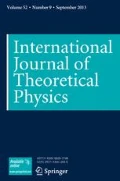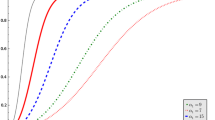Abstract
An operatorial theoretical model based on raising and lowering fermionic operators for the description of the dynamics of a political system consisting of macro–groups affected by turncoat–like behaviors is presented. The analysis of the party system dynamics is carried on by combining the action of a suitable quadratic Hamiltonian operator with specific rules (depending on the variations of the mean values of the observables) able to adjust periodically the conservative model to the political environment.



Similar content being viewed by others
References
Johnson, P.E.: Formal theories of politics. Mathematical modelling in political science. Elsevier Ltd, Pergamon (1989)
Lichtenegger, K., Hadzibeganovic, T.: The interplay of self–reflection, social interaction and random events in the dynamics of opinion flow in two–party democracies. Int. J. Mod. Phys. C 27 (05), 1650065 (2012). https://doi.org/10.1142/S0129183116500650. http://www.worldscientific.com/doi/pdf/10.1142/S0129183116500650
Misra, A.K.: A simple mathematical model for the spread of two political parties. Nonlinear Anal. Modell. Control 17, 343–354 (2012)
Sened, I.: A model of coalition formation: theory and evidence. J. Polit. 58, 350–372 (1996)
Khrennikova, P., Haven, E., Khrennikov, A.: An application of the theory of open quantum systems to model the dynamics of party governance in the US political system. Int. J. Theor. Phys. 53, 1346–1360 (2014)
Khrennikova, P.: Quantum dynamical modeling of competition and cooperation between political parties: the coalition and non–coalition equilibrium model. J. Math. Psychol. 71, 39–50 (2016)
Merzbacher, E.: Quantum mechanics. J. Wiley, New York (1970)
Roman, P.: Advanced Quantum Mechanics. Addison–Wesley, New York (1965)
Bagarello, F.: Quantum Dynamics for Classical Systems: with Applications of the Number Operator. J. Wiley, New York (2012)
Bagarello, F., Oliveri, F.: An operator description of interactions between populations with applications to migration. Math. Mod. Meth. Appl. Sci. 23, 471–492 (2013)
Bagarello, F., Haven, E.: The role of information in a two–traders market. Phys. A Stat. Mech. Appl. 404, 224–233 (2014)
Bagarello, F., Haven, E.: Toward a formalization of a two traders market with information exchange. Phys. Scr. 90(1), 015203 (2015). http://stacks.iop.org/1402-4896/90/i=1/a=015203
Bagarello, F., Oliveri, F.: Dynamics of closed ecosystems described by operators. Ecol. Model. 275, 89–99 (2014)
Bagarello, F., Gargano, F., Oliveri, F.: A phenomenological operator description of dynamics of crowds: escape strategies. Appl. Math. Model. 39, 2276–2294 (2015)
Bagarello, F., Cherubini, A.M., Oliveri, F.: An operatorial description of desertification. SIAM J. Appl. Math. 76, 479–499 (2016)
Di Salvo, R., Oliveri, F.: An operatorial model for long–term survival of bacterial populations. Ricerche mat. 65, 435–447 (2016)
Di Salvo, R., Oliveri, F.: On fermionic models of a closed ecosystem with application to bacterial populations. AAPP–Phys. Math. Nat. Sci. 94(2), A5 (2016). https://doi.org/10.1478/AAPP.942A5
Bagarello, F.: An operator view on alliances in politics. SIAM J. Appl. Math. 75, 564–584 (2015)
Bagarello, F., Haven, E.: First results on applying a non–linear effect formalism to alliances between political parties and buy and sell dynamics. Phys. A 444, 403–414 (2016)
Peterson, M.: The Prisoner’s Dilemma. Cambridge University Press, Cambridge (2015)
Rothe, J.: Economics and Computation: an Introduction to Algorithmic Game Theory, Computational Social Choice, and Fair Division. Springer, Berlin (2016)
Di Salvo, R., Oliveri, F.: An Operatorial Model for Complex Political System Dynamics. Math. Meth. Appl. Sci. https://doi.org/10.1002/mma.4417 (2017)
Di Salvo, R., Gorgone, M., Oliveri, F.: (H, ρ)–Induced Political Dynamics: Facets of the Disloyal Attitudes Into the Public Opinion. Int. J. Theor. Phys. https://doi.org/10.1007/s10773-017-3380-0 (2017)
Bagarello, F., Di Salvo, R., Gargano, F., Oliveri, F.: (H, ρ)–induced dynamics and the quantum game of life. Appl. Math. Model. 43, 15–32 (2016)
Bagarello, F., Di Salvo, R., Gargano, F., Oliveri, F.: (H, ρ)–Dynamics and Large Time Behaviors, Submitted (2016)
Acknowledgements
The research was partially funded by the Ph.D. School in Mathematics and Computer Science of the University of Catania.
Author information
Authors and Affiliations
Corresponding author
Rights and permissions
About this article
Cite this article
Di Salvo, R., Gorgone, M. & Oliveri, F. Political Dynamics Affected by Turncoats. Int J Theor Phys 56, 3604–3614 (2017). https://doi.org/10.1007/s10773-017-3525-1
Received:
Accepted:
Published:
Issue Date:
DOI: https://doi.org/10.1007/s10773-017-3525-1




